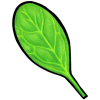Maturity and Quality
Spinach is selected for size and maximal recovery of clean leaves that are mid-maturity to young. Older and yellowing leaves are avoided when making the harvest cut. Generally 3-4 weeks of re-growth are required before a second harvest will yield adequate volume.
Spinach, whether bunched or as leaves, should be uniformly green (generally not yellow-green), fully turgid, fairly clean, and free from serious damage. For bunched spinach, roots should be trimmed short to grade standards and petioles should be predominantly shorter than the leaf blade.
U.S. Grades: Bunched — U.S. No. 1, No. 2 (Oct. 1987). Leaves — U.S. Extra No. 1, No. 1, Commercial (Dec. 1946)
Postharvest Handling and Storage
0°C (32°F)
Spinach is highly perishable and will not maintain good quality for more than 2 weeks. Wilting, yellowing of leaves, and decay are likely to increase following storage beyond 10-14 days; faster at common distribution conditions of 5 to 10°C (41 to 50°F).
In a 1994 UC Davis study, an average of 17, 28, and 45% of leaves of 16 varieties had decay after 2, 3, and 4 weeks at 5°C, respectively. After the same periods at 5°C, 18, 25, and 45% of the leaves showed some yellowing. Commercial varities such as Imperial Spring, Shasta, Polka, Spectrum and Sporter had notably longer shelf- life than did varieties Bossanova, Spark and Space.
| Temperature °C |
Temperature °F |
ml CO2/kg·hr |
| 0 | 32 | 9-11 |
| 5 | 41 | 17-29 |
| 10 | 50 | 41-69 |
| 15 | 59 | 67-111 |
| 20 | 68 | 86-143 |
To calculate heat production, multiply ml CO2/kg·hr by 440 to get BTU/ton/day or by 122 to get kcal/metric ton /day.
Spinach is highly sensitive to exogenous ethylene. Accelerated yellowing will result from low levels of ethylene during distribution and short-term storage. Do not mix loads such as apples, melons and tomatoes with spinach.
95-98%
Atmospheres of 7-10% O2 and 5-10% CO2 offer moderate benefit to spinach by delaying yellowing. Spinach is tolerant to higher CO2 concentration but no increase in benefits has been observed. Package film for prewashed spinach leaves is selected to maintain 1-3% O2 and 8-10% CO2.
Disorders
Freezing Injury. Freezing injury will be initiated at -0.3°C (31.5°F). Freezing injury results in watersoaking typically followed by rapid decay by soft-rot bacteria.
Yellowing. Spinach is highly sensitive to exogenous ethylene (See Response to Ethylene).
Harvesting and handling should be done with care to prevent damage to the petioles and leaves. Bunching ties should not be too tight as crushed or split petioles may lead to rapid decay.
Bacterial Soft-Rot (primarily Erwinia and Pseudomonas) is a common problem. Decay is usually associated with damaged leaves and stems.
Special Considerations
Package-icing and top-icing loads may be used. Frequent light misting may be done in displays to delay wilting of bunched spinach.



